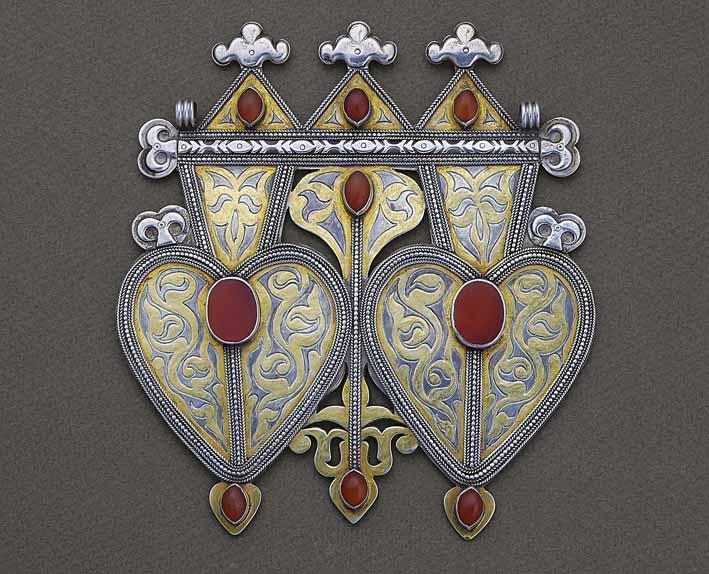IN THE HEART of the Northern Village of Seoul in Bukchon, South Korea resides a fascinating private museum displaying all that glitters within an innovative design space. This is the World Jewellery Museum, the first museum in Asia devoted to jewellery and the result of 40 years of passionate collecting by the wife of a diplomat, founder and director of the museum, Lee Kang-won. The fundamental mission of the World Jewellery Museum is to preserve, collect and exhibit works of jewellery in order to foster the understanding of history, society, art and the spirit of various nations through its permanent display as well as exhibitions of traditional and contemporary jewellery that explore issues of identity and cultural exchange.
The history of jewellery stretches as far back as 40,000 years into prehistoric times, throughout which it has served, like textiles, as a medium of expression for either social status and identity through its symbolic elements, for protection as a talisman, as a source of social and economic status, or for decorative purposes as a form of personal adornment. Moreover, the artistic force of the craftsmen enables jewellery to serve as a form of record for time periods and regional areas of the world right up to this contemporary day and age.
With a collection of 1,600 pieces from Asia, the World Jewellery Museum’s exhibition space is spread over nine galleries housed on three floors, using innovative design and spatial techniques to utilise fully the relatively small space of the museum that is typical of buildings in this part of Seoul. In one of the galleries is a display of 250 multi- coloured beaded necklaces where the items are draped across three huge light poles. Highlights from these galleries include a decorative enamelled lapis lazuli necklace from Pakistan and silver and coral enamelled Mongolian temple pendants.
The galleries are based on the function of the jewellery as opposed to the country of origin or the historic period, so as to convey the cross-cultural influences reflected in the design and concept of jewellery and later this year an exhibition about Western contemporary jewellery artists who are influenced by Asian traditional craft techniques will be also curated at the museum.
On entering the museum, one is presented with the Jewellery Garden, a personal selection by the director of nine highlights encased in glass cubes including a Turkmen back ornament in the shape of a heart to ward of evil spirits for protection, a silver-gilt Tibetan tinderbox with coral and turquoise inlay used as a talisman, and a Qing dynasty silver-gilt hair pin with kingfisher feathers with coral and pearl inlay.
The lighted circular windows of the amber wall contain an array of amber items including beads from China and Japan. Likewise, the bracelet and anklet wall display silver, bronze and ivory ornaments worn on the arms and legs by tribes from Asia as symbols of power, wealth or as protective charms such as the Pakistani silver bracelets from Swat. The Modern Jewellery gallery brings the museum forward into the 21st century with its Dialogue in Time – a display of 250 highlights from the collection, including jewellery and design works by contemporary artists such as the Korean artist Yun Sang-hee whose Beautiful Footprint bracelet, created out of wood, mother-of-pearl and ottchil Korean lacquer was produced in 2009.
Besides the permanent exhibition space, the museum puts on a series of temporary exhibitions, which are displayed on the second floor and curated by the Deputy Curator, Elaine Kim, the daughter of Mrs Lee, such as From China, which included jewellery of the Miao, a tribal ethnic minority group. This exhibition was organised as an opportunity to further strengthen the cultural bridge between Korea and China in which 180 jewellery items of the Han Chinese and the minority groups dwelling in China.
Possessing a completely oral tradition with no written language, the Miao’s traditions are expressed in their art of jewellery with 50 different shapes, some of which are extremely heavy to wear, such as the layered ring necklaces weighing up to five kilograms each. A complete set of Miao jewellery replete with large silver back ornaments were on show along with festive neck rings engraved with dragons and phoenixes amidst floral motifs, weighing up to 10 kilograms.
The importance of such a museum displaying traditional jewellery from ethnic cultures across the world cannot be ignored what with the demise of traditional craftsmen and the subsequent loss of symbolic meanings what with the advent of globalization and modernization in this day and age.
BY JASLEEN KANDHARI
World Jewellery Museum, 75-3, Hwa-dong, Jongno-gu, Seoul, South Korea, www.wjmuseum.com

